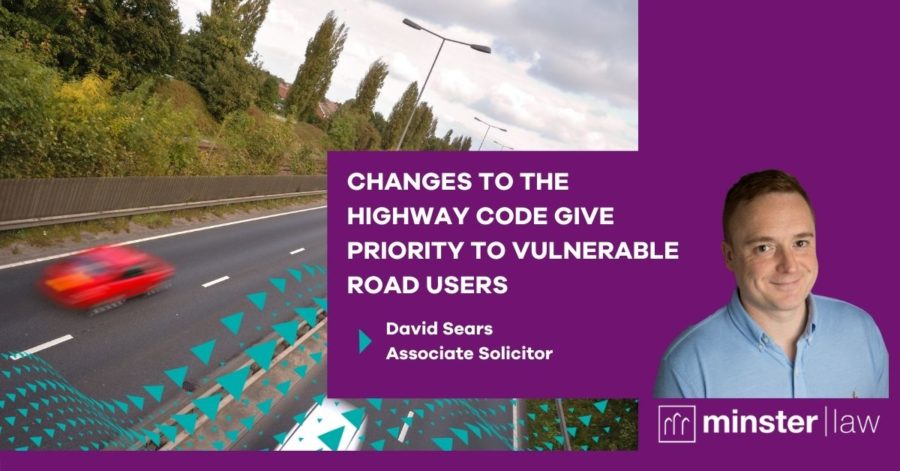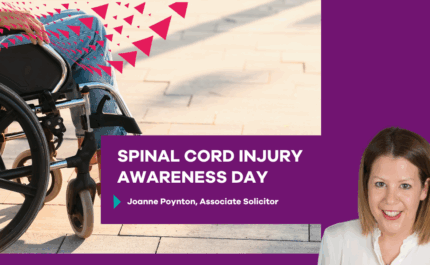
Following a government consultation, the Highway Code will be amended on January 29th, with some big changes coming to how we need to drive; Associate Solicitor David Sears shares the bits we all need to be aware of.
The impending changes are yet to be finalised, but a summary of the consultation proposals was released last month.
While some of the changes are quite minor, the changes are wide-ranging. Some of them signal a sea-change in how the Highway Code stipulates road users should interact with each other, by introducing a hierarchy of road users – this ensures those road users who do the greatest harm have extra responsibility to reduce the danger or threat they pose to others. This approach supplements the introduction of ‘Vulnerable Road Users’ in the recent whiplash reforms, which excluded pedestrians, cyclists, scooters, wheelchair users, mobility scooter riders and horse riders.
A new rule is being introduced but it states the objective is not to give priority to pedestrians, cyclists, and horse riders in every situation, but ensure a more mutually respectful and considerate culture of safe and effective road use.
Major changes to the Highway Code include:
Rule 8 – The new rule stipulates that at junctions traffic should now give way to pedestrians.
Rule 19 – Rather than waiting for pedestrians to enter a zebra crossing, as is currently the case, the new rules will stipulate that drivers should give way to pedestrians waiting to cross and must give way to pedestrians on a zebra crossing.
Rule 59 – Regarding the use of clothing for cyclists, this rule will be amended to state that evidence suggests wearing a cycle helmet will reduce risk of sustaining a head injury in certain circumstances.
Rule 63 – Providing guidance on cycling in shared spaces and to not pass pedestrians, horse riders or horse drawn vehicles closely or at high speed, particularly from behind. Guidance is given as to the distances to be given and speeds to be used.
Rule 73 to merge with – If cyclists are going straight ahead at a junction they have priority over traffic waiting to turn into or out of the side road, unless signs or markings indicate otherwise. Check that you can proceed safely, particularly when approaching junctions alongside stationary or slow-moving traffic. Watch for drivers intending to turn across your path. Remember the driver ahead may not be able to see you, so bear in mind your speed and position in the road. Be particularly careful alongside lorries and other long vehicles, as their drivers may find it difficult to see you. Remember that they may have to move over to the right before turning left, and that their rear wheels may then come very close to the kerb while turning.
Change rule 77 to Rule 79 – Cyclists on a roundabout can ride in the left or right-hand lanes and move left when approaching their junction. The cyclist should position themselves in the centre of the lane and signal right to indicate that they are not leaving the roundabout.
Rule 140 – Motorists should give way to cyclists in a cycle lane even when approaching from behind and drivers should await a safe gap before turning across a cycle lane.
Rule 151 – Drivers and riders in slow moving traffic should allow pedestrians and cyclists to pass in front of them.
Rule 163 – Cyclists may pass slower moving or stationary traffic on the right or left including approaching junctions. The current rule states that passing on the left should only be done if the vehicle in front is signalling to turn right.
Rule 163 – Gives more detailed guidance on the space to be given by drivers when passing motorcyclists, cyclists, horse riders and horse drawn vehicles.
Rule 170 – Will advise drivers and riders to give way to pedestrians waiting to cross and to remain behind cyclists and motorcyclists at junctions.
Rule 239 – Will be updated to recommend that road users should open their door using the ‘Dutch Reach’ method to reduce the risk of ‘dooring’ cyclists and motorcyclists.
In a nod to the of motor vehicles, Rule 239 will also be amended to minimise danger from electric charging cables. These changes state that ‘when using an electric vehicle charge point you should park close to the charge point and minimise the danger to pedestrians from tripping over charging cables. After using the charge point you should return charging cables and connectors neatly to prevent creating an obstacle for other road users.’
Although the changes to the Highway Code are proposed to create more respectful road use there has been criticism that the changes have not been widely publicised and some of the text has not been finalised.
Indeed, a recent AA survey of its members suggested that two-thirds of respondents were unaware of the impending changes. If a large proportion of the population is unaware of the changes then this is only likely to cause confusion, increase risks for road users and lead to confrontation.



